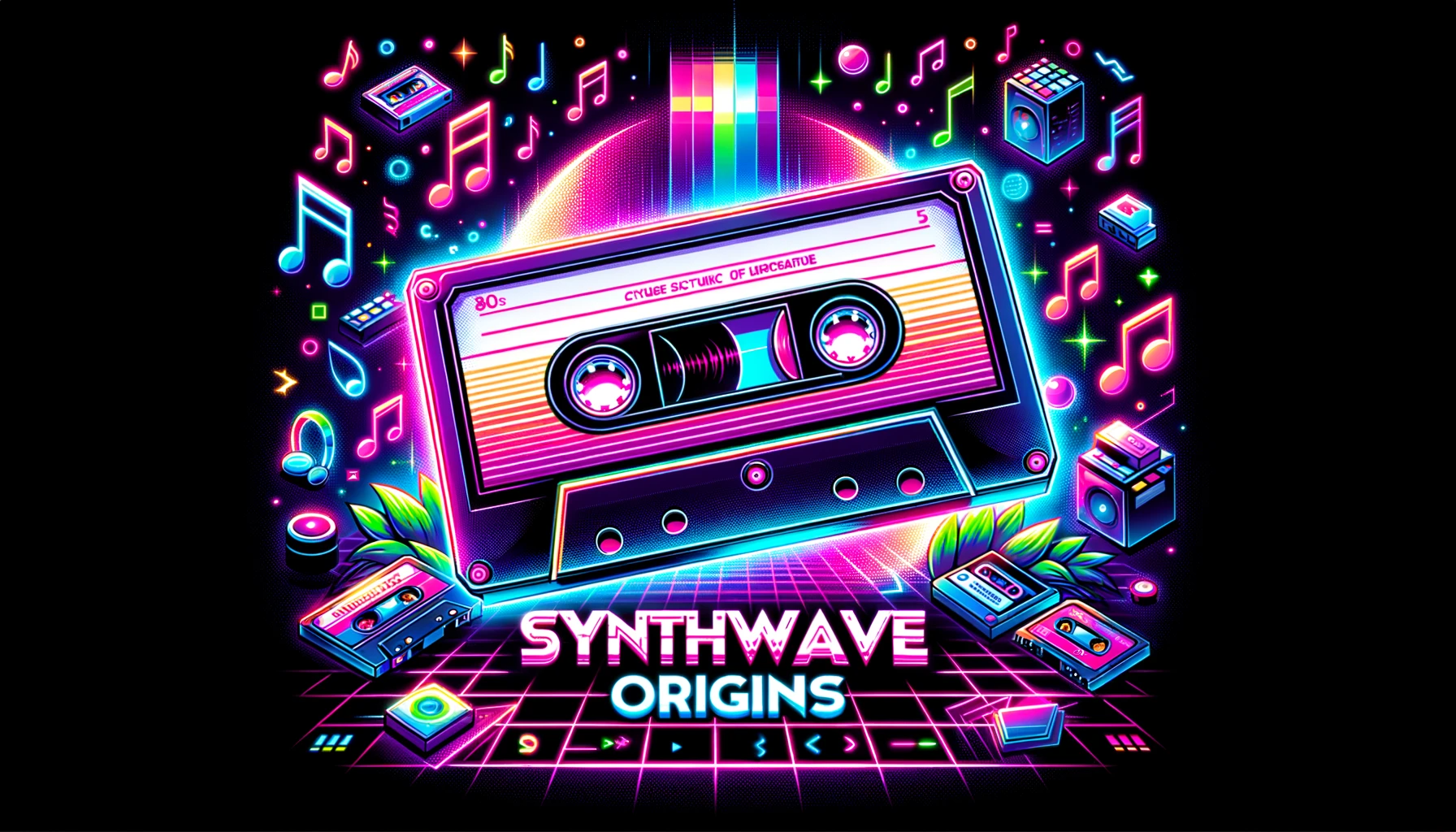No products in the cart.

I've delved deep into the origins of synthwave music and unearthed some truly captivating facts.
From its humble beginnings in the 1980s to its influence on mainstream music today, this genre has a rich history that's worth exploring.
Join me as we uncover the early pioneers, the rise of digital technology, and the impact of retro gaming on synthwave's sound.
Get ready to dive into the fascinating world of synthwave and discover its enduring legacy.
Being a fan of Synthwave music, I find the birth of this genre to be an intriguing story. Synthwave emerged in the late 2000s as a nostalgic homage to the sounds of the 1980s.
One of the most fascinating aspects of Synthwave is its influence on fashion. The genre's music videos and album covers often feature neon lights, retro aesthetics, and futuristic imagery, which has inspired a resurgence of 80s-inspired fashion trends.
The connection to cyberpunk is also significant. Synthwave draws inspiration from the dystopian visions of the cyberpunk genre, incorporating elements such as futuristic technology, urban decay, and a sense of rebellion. This connection has helped to shape the visual and thematic aspects of Synthwave, making it a truly immersive and compelling genre.
Drawing from the sounds and styles of the 1980s, Synthwave music captures the essence of a bygone era and reimagines it for modern listeners.
One of the major influences of the 80s on Synthwave is its impact on fashion. The 80s were known for their bold and flamboyant fashion choices, characterized by neon colors, spandex, and oversized accessories. Synthwave artists often embrace this aesthetic, sporting retro-inspired outfits and incorporating neon visuals into their album covers and music videos.
Another significant influence is the role of technology in the 80s. The advent of synthesizers, drum machines, and other electronic instruments revolutionized the music industry. Synthwave artists draw upon these iconic sounds to create the nostalgic, futuristic melodies that define the genre.
The combination of fashion and technology from the 80s has shaped Synthwave into the captivating musical movement it's today.
During my research on the origins of Synthwave music, I discovered the pivotal role played by early pioneers and producers in shaping the genre's distinctive sound.
Synthwave pioneers were at the forefront of the movement, experimenting with new sounds and pushing the boundaries of electronic music. Their creative process involved utilizing vintage synthesizers and drum machines to create a nostalgic and futuristic blend of sounds.
Through their early experimentation, they developed the signature elements of Synthwave, such as pulsating basslines, soaring melodies, and retro-inspired aesthetics.
These pioneers weren't afraid to take risks and explore uncharted territory, resulting in a genre that's both nostalgic and innovative.
Their contributions laid the foundation for the future growth and popularity of Synthwave music.
As I delved further into the origins of Synthwave music, I discovered that the rise of digital technology played a significant role in shaping the genre's evolution. The advent of electronic music allowed artists to experiment with new sounds and textures, resulting in the birth of a unique genre like Synthwave.
Here are three key ways in which the rise of digital technology impacted Synthwave and contemporary artists:
The rise of digital technology not only revolutionized the production process but also had a profound impact on the creativity and expression of contemporary artists in the Synthwave genre.
I discovered an intriguing connection between retro gaming and Synthwave. One of the defining features of Synthwave is its use of music production techniques that harken back to the soundtracks of classic video games.
Retro gaming, with its nostalgic appeal, has heavily influenced the music style. Synthwave artists often incorporate 8-bit sounds in their tracks, reminiscent of the sounds produced by early gaming consoles like the NES and Sega Genesis. These 8-bit sounds add a unique and recognizable element to the music, evoking feelings of nostalgia and transporting listeners back to the golden age of gaming.
The fusion of retro gaming and Synthwave creates a sonic experience that's both familiar and innovative, capturing the essence of a bygone era while pushing the boundaries of modern music production.
Exploring the influence of film soundtracks on Synthwave, I discovered a wealth of inspiration in the iconic music of the silver screen. Synthwave, with its nostalgic and futuristic blend, owes much of its aesthetic to the atmospheric compositions found in cult films of the 1980s and 1990s.
Here are three film soundtracks that played a significant role in shaping the synthwave genre:
These film soundtracks not only influenced the sound of synthwave but also played a crucial role in shaping modern electronic music production techniques.
Continuing the discussion from the previous subtopic, I found a fascinating connection between Synthwave and Vaporwave.
Vaporwave emerged in the early 2010s as an internet-based music genre that sampled and manipulated popular songs from the 1980s and 1990s. It drew inspiration from the consumer culture and aesthetics of that era, creating a nostalgic and surreal soundscape.
Vaporwave's connection to synthwave lies in their shared interest in retrofuturism and nostalgia. While synthwave takes inspiration from the film soundtracks of the 1980s, vaporwave incorporates elements from various genres, including synthwave, to create a unique and distinct musical style.
Vaporwave's cultural impact can be seen in its influence on visual art, fashion, and internet culture, making it an important part of the broader electronic music landscape.
Building upon the connection to Vaporwave, the global appeal of Synthwave has grown exponentially in recent years. This genre's unique blend of nostalgic 80s sound and futuristic elements has captivated audiences around the world.
Here are three key aspects that contribute to Synthwave's widespread popularity:
The global appeal of Synthwave can be attributed to its influence on fashion, impact on visual arts, and its accessibility to a wide audience.
Nostalgia plays a crucial role in shaping the allure and appeal of Synthwave music. The psychology of nostalgia reveals that it's a powerful emotion that allows individuals to revisit and relive positive memories from the past. Synthwave, with its nostalgic sound and aesthetic, taps into this emotional connection, transporting listeners back to the 1980s.
The genre's use of synthesizers, drum machines, and retro-inspired visuals creates a sense of familiarity and comfort, evoking a longing for a simpler time. The music's dreamy melodies and pulsating beats further enhance the nostalgic experience, transporting listeners to a neon-lit world of retro-futurism.
As an avid fan of Synthwave music, I've witnessed firsthand the profound impact that social media has had on the genre's origins. Social media platforms such as Instagram, Twitter, and YouTube have played a crucial role in promoting and popularizing synthwave music. Here are three key ways in which social media has influenced the accessibility and distribution of synthwave music:
Social media's impact on the accessibility and distribution of synthwave music has also influenced the development and proliferation of its different subgenres. One notable subgenre that has emerged within the synthwave community is 'retrowave,' characterized by its heavy use of 80s-inspired synth sounds and nostalgic themes. Retrowave often incorporates elements of pop, rock, and electronic music, creating a unique blend of past and present.
Another subgenre, 'outrun,' draws inspiration from 80s action movies and video games, with its fast-paced, energetic beats and futuristic atmospheres. Synthwave's influence on fashion can also be seen in subgenres like 'vaporwave,' which combines synthwave sounds with glitchy, lo-fi aesthetics.
The influence of synthwave music on mainstream music can be observed in various ways.
One notable aspect of synthwave music's influence on mainstream culture is the distinct and captivating synthwave aesthetic. Synthwave's visual aesthetics are heavily inspired by the retro-futuristic imagery of the 1980s. Neon lights, vibrant colors, and futuristic cityscapes are common themes in synthwave album covers and music videos.
This visual style hasn't only permeated the music scene but has also influenced fashion trends. The bold and nostalgic elements of synthwave have found their way into clothing, with the resurgence of 80s-inspired fashion. From oversized blazers and high-waisted jeans to bold patterns and bright colors, the synthwave aesthetic has made a significant impact on the fashion industry.
The fusion of music and visual aesthetics has created a captivating and immersive experience for fans of synthwave.
As an avid fan of synthwave, I'm excited to explore the future directions that this genre of music is taking. Synthwave is constantly evolving, pushing the boundaries of its soundscapes and creating new sonic experiences.
Here are three exciting developments to look forward to:
The future of synthwave is bright, with exciting collaborations and evolving soundscapes that will keep fans like myself eagerly anticipating what's to come.
The term 'synthwave' originated from the combination of 'synth' (short for synthesizer) and 'wave' (representing the music's waveforms). It perfectly captures the genre's retro futuristic sound, which is characterized by its heavy use of synthesizers and nostalgic 80s vibes.
Synthwave's popularity transcends borders and is embraced by enthusiasts worldwide. Online streaming platforms have played a significant role in spreading this genre's influence across different regions and cultures, contributing to its global success.
There are several subgenres within the synthwave genre, such as outrun and darkwave. Each subgenre has its own distinct characteristics and influences, adding depth and variety to the overall synthwave sound.
Social media has had a significant impact on the growth and popularity of synthwave. Artists who actively engage with their fans on platforms like Twitter and Instagram have gained a larger following and wider recognition.
There are several mainstream music artists who have been influenced by synthwave, such as The Weeknd, Dua Lipa, and Halsey. Additionally, synthwave has made its way into film soundtracks, adding a nostalgic and futuristic touch to the music.
